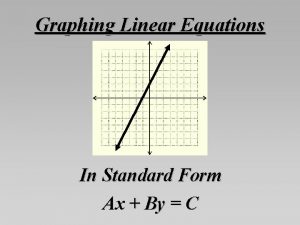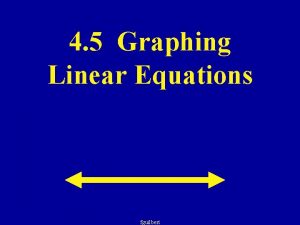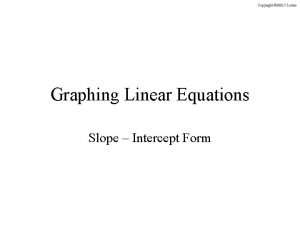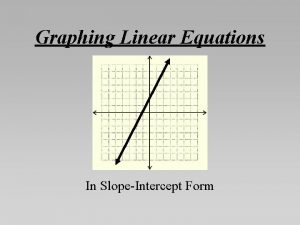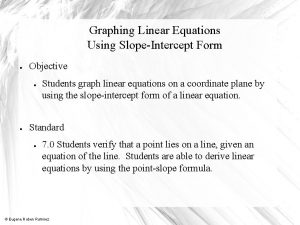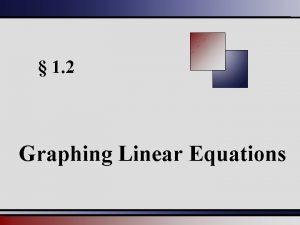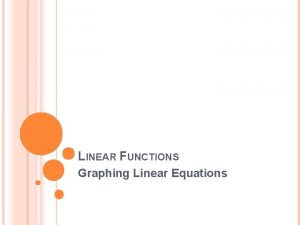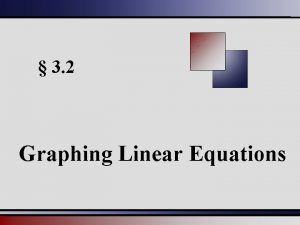Graphing Linear Equations y x In SlopeIntercept Form












- Slides: 12

Graphing Linear Equations y x In Slope-Intercept Form

Linear equations have two variables and when we plot all the (x, y) pairs that make the equation true we get a line. We will use The Slope-Intercept Form of the equation to graph the line.

The formula for Slope-Intercept Form is: ‘b’ is the y-intercept. (where the line crosses the y-axis) ‘m’ is the slope. Using the y-intercept as a starting point, you can use the slope to graph more points and the line of the equation.

These equations are all in Slope-Intercept Form: Notice that these equations are all solved for y.

Just by looking at an equation in this form, we can draw the line on a coordinate plane. • The constant is the y-intercept. • The coefficient is the slope. Constant = 1, y-intercept is (0, 1). Coefficient = 2, slope is 2. Constant = -4, y-intercept is (0, -4). Coefficient = -1, slope = -1. Constant = -2, y-intercept is (0, -2). Coefficient = 3/2, slope = 3/2.

right 1 up 2 1) Plot the y-intercept as a point on the y-axis. 2) 3) The constant, b = 1, so the y-intercept = 1. or ( 0 , 1 ) 2) The coefficient, m = 2, so the slope is positive 2 over 1. 3) Plot more points by counting the slope up the numerator and across the denominator.

1) Plot the y-intercept as a point on the y-axis. 2) The constant, b = 4, so the y-intercept is… 2) 3) The coefficient, ( 0 , -4 ) m = -1, so the slope is left 1 up 1 down 1 right 1 3) negative 1 over 1. 4) 3) Plot more points by counting the slope up (the numerator) and across (the denominator).

1) Plot the y-intercept as a point on the y-axis. right 2 up 3 2) The constant, b = 2, so the y-intercept is… 3) ( 0 , -2 ) 2) The coefficient, m = 3/2, so the slope = 3/2. 3) Plot more points by counting the slope up the numerator and across the denominator.

Sometimes we must solve the equation for y before we can graph it. To solve for y, we must move the 2 x to the other side… Subtract 2 x from both sides. – 2 x The constant, b = 3 tells the y-intercept. The coefficient, m = -2 is the slope: negative 2 over 1

left 1 up 2 down 2 right 1 1) Plot the y-intercept as a point on the y-axis. 2) The constant, b = 3, so the y-intercept = 3. 2) The coefficient, m = -2, so the slope = -2/1. 3) Plot more points by counting the slope up the numerator and across the denominator.

Summary Slope-Intercept Form ‘b’ is the y-intercept. ‘m’ is the slope.

PUT THE TITLE ON YOUR PAPER.
 Slopeintercept form
Slopeintercept form Slopeintercept form
Slopeintercept form 2-4 writing linear equations
2-4 writing linear equations Slopeintercept form
Slopeintercept form How to graph equations in standard form
How to graph equations in standard form 4-5 graphing linear equations
4-5 graphing linear equations Graphing linear equations definition
Graphing linear equations definition Lesson 5 graphing linear equations and inequalities
Lesson 5 graphing linear equations and inequalities Graphing linear equations vocabulary
Graphing linear equations vocabulary 4-1 graphing equations in slope-intercept form
4-1 graphing equations in slope-intercept form Quadratic simultaneous equations
Quadratic simultaneous equations Difference between linear and nonlinear
Difference between linear and nonlinear Simultaneous equations linear and non linear
Simultaneous equations linear and non linear




